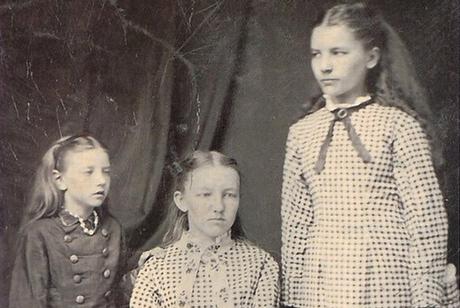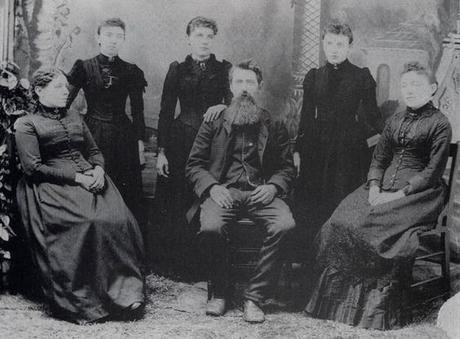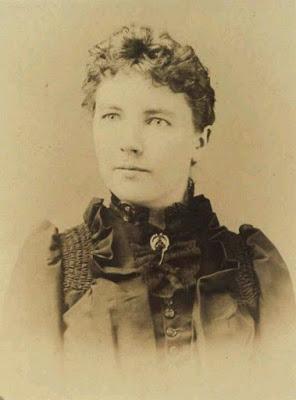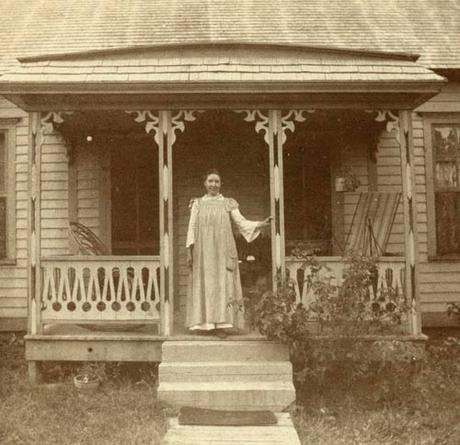
Quest'oggi voglio raccontarvi della vita di una donna straordinaria che divenne, solamente in età avanzata, una prestigiosa scrittrice di libri per fanciulli e che rimane tutt'ora un'ideale da perseguire per ciascuno di noi per le lezioni che dalla vita seppe trarre.
Laura Elizabeth Ingalls nacque il 7 febbraio del 1867 nei Big Woods, I Grandi Boschi del Wisconsin, sette miglia a nord di Pepin, seconda di quattro figli. Quando ella doveva descrivere il carattere del padre, Charles Philip Ingalls, lo definiva come costantemente allegro, al punto da apparire persino sconsiderato, talvolta, sempre pronto ad allietare la famiglia prendendo il mano il suo violino e facendo suonare le sue corde per tenere alto il morale di tutti, mentre la madre Caroline Lake Quiner, insegnante, appariva agli occhi della figlia come una donna dolce ed educata, gentile, ed orgogliosa; le sue sorelle, erano Mary, la maggiore, nata nel 1865, Carrie e Grace, più giovani di lei, rispettivamente nate nel 1870 e nel 1877; Laura avrà anche un fratello minore, Charles Jr. (soprannominato Freddie), che nacque nel 1875 e che si spense all'età di soli nove
mesi.

Caroline Celestia-Carrie, Mary Amelia e Laura Elizabeth fotografate nel 1875.

Charles & Caroline Ingalls, 'Pa e Ma'
Da bambina Laura si trasferì con la famiglia da un posto all'altro in tutto quello che potremmo definire il cuore dell'America; ispirato dalla legge Homestead Act promulgata da Lincoln nel 1862 che offriva 160 acri di "terra libera" ai coloni che vi avrebbero costruito una fattoria e avessero su di essa vissuto per cinque anni, Pa condusse la sua famiglia nelle grandi praterie.
 Interno di una tipica casa pioniera ed, accanto , la fedele ricostruzione della dimora in cui nacquero Mary e Laura nei Big Woods del Wisconsin.
Interno di una tipica casa pioniera ed, accanto , la fedele ricostruzione della dimora in cui nacquero Mary e Laura nei Big Woods del Wisconsin. Dopo la piantagione di numerose colture, la famiglia Ingalls fu costretta a lasciare questa terra nell'autunno del 1870, subito dopo la nascita di Carrie: Pa aveva udito voci secondo cui il governo aveva cambiato idea circa l'insediamento in quella porzione dello Stato e che i soldati erano in viaggio per costringere i coloni già stabilitivisi ad abbandonarla; egli non attese i soldati e nel 1871 ripresero possesso della loro vecchia casa nel Wisconsin, poiché la famiglia svedese a cui l'avevano venduta non intendeva ultimarne il pagamento ed aveva deciso di lasciarla, ma già solamente tre anni più tardi, nel 1874, gli Ingalls erano nuovamente in viaggio verso le praterie, questa volta del Minnesota, dove si stabilirono a Walnut Grove, vivendo dapprincipio in una casa-rifugio.

Due anni più tardi, si spostarono a Burr Oak, Iowa, dove Charles diverrà co-proprietario di un hotel, Caroline aiuterà soprattutto in cucina e le fanciulle si adopereranno per rassettare le stanze degli ospiti,
 The Masters Hotel, Burr Oak, IOWAma il richiamo che Pa avvertiva per la natura e la vita nella prateria, pur se ben più faticosa ed incerta, era talmente forte e dirompente che entro l'autunno del 1877 fecero tutti ritorno a Walnut Grove; nel 1879, lo spirito irrequieto di Charles Ingalls lo spinse a guidare la sua famiglia nel territorio del Dakota, dove si stabilirono in quella quella che sarebbe diventata De Smet, nel South Dakota, che rimase la dimora di Charles e Caroline per il resto della loro vita e purtroppo fu proprio durante quello stesso anno che Mary ebbe un attacco ischemico dal quale si riprese, ma perse totalmente la vista. Il loro secondo inverno a De Smet fu il peggiore che fu mai ricordato: numerose bufere di neve impedirono ai treni di consegnare tutte le forniture isolando la città da dicembre a maggio, e furono questi ricordi di giorni vissuti tra stenti e rinunce che segnarono la vita della giovane Laura forgiandone il carattere: ella ricorderà infatti, anni dopo, di aver cercato di sopravvivere allora alle rigide temperature, alla mancanza di cibo, di legna da ardere, e alla privazione di altre primarie necessità.
The Masters Hotel, Burr Oak, IOWAma il richiamo che Pa avvertiva per la natura e la vita nella prateria, pur se ben più faticosa ed incerta, era talmente forte e dirompente che entro l'autunno del 1877 fecero tutti ritorno a Walnut Grove; nel 1879, lo spirito irrequieto di Charles Ingalls lo spinse a guidare la sua famiglia nel territorio del Dakota, dove si stabilirono in quella quella che sarebbe diventata De Smet, nel South Dakota, che rimase la dimora di Charles e Caroline per il resto della loro vita e purtroppo fu proprio durante quello stesso anno che Mary ebbe un attacco ischemico dal quale si riprese, ma perse totalmente la vista. Il loro secondo inverno a De Smet fu il peggiore che fu mai ricordato: numerose bufere di neve impedirono ai treni di consegnare tutte le forniture isolando la città da dicembre a maggio, e furono questi ricordi di giorni vissuti tra stenti e rinunce che segnarono la vita della giovane Laura forgiandone il carattere: ella ricorderà infatti, anni dopo, di aver cercato di sopravvivere allora alle rigide temperature, alla mancanza di cibo, di legna da ardere, e alla privazione di altre primarie necessità.
La famiglia Ingalls - Da sinistra verso destra: Ma Caroline Ingalls seduta, Grace Ingalls. Laura, Pa Charles Ingalls seduto, Carrie e Mary Ingalls, 1885-90.

Educata secondo i più saldi principi etici e religiosi, all'umiltà e alla rinuncia, alla disciplina e alla mansuetudine Laura, già di indole dignitosa e volitiva, crebbe con un carattere difficilmente rinunciatario e forte; a causa dei frequenti spostamenti della sua famiglia ella fu comunque in grado di frequentare la scuola con la sorella Mary, quando era loro possibile, altrimenti studiava a casa come autodidatta. Nel 1882, all'età di quindici anni, ricevette il suo certificato di insegnamento e per tre anni insegnò in una piccola scuola di campagna situata ad una dozzina di miglia dalla sua dimora a De Smet: fu in questo periodo che ella conobbe Almanzo James Wilder ( 13 febbraio 1857 ),

di dieci anni più grande di lei, giovane dalle buone maniere che si era stabilito nelle vicinanze del piccolo centro nel 1879 insieme con il fratello Royal, il quale ben presto conquistò il suo cuore; Almanzo spesso accompagnava Laura a scuola o andava a prenderla al termine delle lezioni per ricondurla a casa con la sua slitta od il suo carro, a seconda delle stagioni, e spesso era invitato a casa dei suoi genitori per visite durante il fine settimana.
Dopo averla corteggiata per poco più di due anni, Almanzo sposò Laura il 25 agosto del 1885 e fu così che la nostra giovane e capace insegnante fu costretta ad abbandonare l'insegnamento per aiutare il marito nella loro grande fattoria ed il 5 dicembre dell'anno successivo nacque Rose, la bellissima, unica figliola dei Wilders.

Sì, perché dovete sapere che se è vero che tutti i pionieri, ovvero quei coloni che tentarono di conquistare, stabilendovisi, nuove terre rubate alla natura selvaggia dell'America ancora inesplorata ed indomita, erano rassegnati a sopportare i disagi e l'incertezza della vita contadina, i Wilders dovettero provare il dolore causato da altre grandi tragedie che segnarono indelebilmente la loro vita: nel mese di agosto del 1889, Laura diede alla luce un bambino che morì poco dopo, un evento di cui non farà menzione alcuna in nessuno dei suoi libri; entrambi contrassero poi la difterite, una terribile malattia che causa problemi respiratori, ma se per Laura si trattò di una forma leggera che non lasciò alcuno strascico sul suo fisico, Almanzo rimase parzialmente paralizzato alle gambe, ovvero alle estremità e perciò, da allora, sempre bisognoso di assistenza; infine, la loro casa, costruita dallo stesso Manly - come Laura amava chiamarlo - venne rasa al suolo da un incendio divampato dalla cucina.
Dopo la malattia, Almanzo fu consigliato dai medici di recarsi in un luogo dal clima più mite e temperato da cui trarre giovamento per i suoi arti provati, e fu allora che i Wilders decisero di spostarsi in Florida, dove da tempo si era stabilito e viveva felicemente un cugino, ma si trattò di un periodo molto breve, una sorta di parentesi nella vita della giovane coppia che amava lavorare la terra del cuore degli States; senza altra dimora fecero quindi ritorno a De Smet, a quella che era per Laura la casa paterna, dove rimasero per un anno durante il quale ella trovò lavoro presso la sarta del paese e mise da parte quel denaro ( cento dollari ) che sarebbe servito loro per l'acquisto della casa dei loro sogni.
 Si sentiva parlare di sviluppo del territorio delle Ozarks Mountains nel sud del Missouri, aziende del territorio facevano circolare immagini patinate di frutteti, di vitelli pasciuti, di colline alberate e torrenti impetuosi, il Missouri sembrava essere una terra promessa. Un vicino di casa di De Smet si recò negli Ozarks per dare un'occhiata e portò una mela dal Missouri e la diede a Laura: era più grande e la più rossa mela che avesse mai visto.
Si sentiva parlare di sviluppo del territorio delle Ozarks Mountains nel sud del Missouri, aziende del territorio facevano circolare immagini patinate di frutteti, di vitelli pasciuti, di colline alberate e torrenti impetuosi, il Missouri sembrava essere una terra promessa. Un vicino di casa di De Smet si recò negli Ozarks per dare un'occhiata e portò una mela dal Missouri e la diede a Laura: era più grande e la più rossa mela che avesse mai visto. Quella mela decise dove la famiglia Wilder si sarebbe successivamente stabilita. 1
Non appena i giorni di primavera cedettero il passo all'estate i Wilders cominciarono il loro viaggio verso Mansfield, nel Missouri, il luogo che avrebbero chiamato 'casa' per il resto della loro vita, 'La Terra delle Grandi Mele Rosse' ( The Land of the Big Red Apple ): era il 17 luglio del 1894, come ebbe ad annotare Laura nel diario che tenne durante tutto il loro viaggio quando il loro carro, bitumato a dovere da Almanzo, si lasciò alle spalle De Smet ( Laura non avrebbe più rivisto i sui adorati genitori ).
La sera prima il violino di Pa che suonava tutte le sere rallegrando l'intera famiglia anche nei periodi più bui e difficili, cui Laura era così affezionata, suonò per lei per l'ultima volta:
Quando il violino suonò le sue ultime note e giunse il momento di mettere a dormire Rose per un risveglio di prima mattina per la partenza, Pa chiese a Laura una promessa d'addio.
"quando me ne sarò andato, quando l'ora giungerà," le disse Pa "voglio che tu abbia il violino."2

Giunti nel territorio degli Ozarks, i Wilders si trovarono in difficoltà nello scegliere una dimora, tante erano le fattorie disponibili ed i luoghi accattivanti in cui poterne edificare altre, ma Laura individuò facilmente il luogo che conquistò il suo cuore, aveva trovato ROCKY RIDGE FARM:

Manly indagò ed apprese che il prezzo della fattoria era di $ 400 - $ 10 per acro. Con essa venivano venduti 400 piccoli alberi di mele in attesa di essere piantati quando la terra sarebbe stata pronta. I precedenti proprietari avevano ordinato quegli alberi di mele da un vivaio. Poi avevano pensato ai lavori connessi con un frutteto e semplicemente abbandonarono le piantine di mele e la fattoria. Utilizzando la banconota da cento dollari a titolo di caparra, i Wilders acquistarono Rocky Ridge Farm il 24 settembre 1894 da The Bank of Mansfield.
Quando i documenti furono firmati in banca, Manly, Laura e Rose immediatamente si diressero verso la loro nuova casa. 3
"Il nostro ideale di casa era quella costruita da un uomo e una donna insieme", disse Laura.
La fattoria di Rocky Ridge dei Wilders crebbe grazie al lavoro congiunto di Laura e Manly che trasformarono la loro terra negli Ozarks in una fattoria frutticola, rinomata per la produzione di latticini ed avicola. Proprio come erano stati partner coltivando grano nel South Dakota, i Wilders erano determinati a creare una fattoria di successo nel Missouri e poichè Manly era ancora indebolita dai suoi storpi, aveva bisogno della rapidità e dell'energia di Laura che divenne la sua migliore aiutante. 4


Anche se entrambi erano interessati a tutti gli aspetti della vita della fattoria di Rocky Ridge, Manly e Laura decisero di dedicarsi ciascuno ad una specialità.
Laura scelse il pollame e parlerà sempre con orgoglio del fatto che vendere i suoi polli e le sue uova durante il primo inverno alla fattoria aveva contribuito a comprare il cibo ed i necessari approvvigionamenti in città. Manly decise che avrebbe gestito le mucche; egli sosteneva che Rocky Ridge fosse un caseificio naturale, con molto buona, limpida acqua di sorgente a disposizione e buona erba da pascolo che cresceva dove gli alberi erano stati abbattuti. Quando lui e Laura acquistarono altri quaranta acri di terreno da aggiungere alla fattoria, vi era davvero lo spazio necessario per allevare un'intera mandria di bestiame. 5
Il tempo del lavoro alla fattoria lasciava vacante qualche ora durante le giornate di Laura, la quale decise di cominciare a scrivere le proprie memorie, pensando a come erano velocemente cambiati i tempi nel corso degli anni in cui ella visse; Rose nel frattempo aveva trovato lavoro come giornalista e la spronò in questo suo intento che però non trovò riscontro alcuno; pensò quindi di cambiare uditorio e di rivolgersi ad un pubblico di età inferiore, che forse avrebbe trovato interessante la vita di una ragazza delle praterie, di una PRAIRIE GIRL: aveva trovato la chiave di volta per il suo successo !
Alla pubblicazione del primo libro, fece seguito quella di altri sette a comporre una sorta di saga della sua vita, ricolma di aneddoti curiosi, di saggezza, di buoni sentimenti.
“I began to think what a wonderful childhood I had had. How I had seen the whole frontier, the woods, the Indian country of the great plains, the frontier towns, the building of railroads in wild, unsettled country, homesteading and farmers coming in to take possession…Then I understood that in my own life I represented a whole period of American history”

Nella speranza che abbiate gradito questo mio 'ritratto' di una donna così tanto eccezionale, come sempre concludo augurandovi il meglio, miei carissimi amici e lettori, ed abbracciandovi con sempre maggiore gratitudine e riconoscenza,
a presto ♥


William Anderson, Laura Ingalls Wilder Country: The People and places in Laura Ingalls Wilder's life and books, Harper Collins, 1990;
William Anderson, Laura Ingalls Wilder: A Biography, Harper Collins, 1992;
Emma Carlson Berne, Nicole Elzenga, Laura Ingalls Wilder, ABDO Publishing Company, 2008;
Wendy McClure, The Wilder Life: My Adventures in the Lost World of Little House on the Prairie, Riverhead Books, Penguin Group USA, 2011.
Citazioni:
1 - William Anderson, Laura Ingalls Wilder: A Biography, Harper Collins, 1992, pag. 141;
2 - Op. cit., pag. 145;
3 - Ibidem, pag. 150;
4 - Ibidem, pag. 152;
5 - Ibidem, pag. 157.

- picture 1
Today I want to tell you the life of an extraordinary woman who became, only in old age, a prestigious writer of books for children, and who still remains an ideal to be pursued for all of us, because of the lessons that she drew from her life.
Laura Elizabeth Ingalls was born February 7th, 1867 in The Big Woods of Wisconsin, seven miles north of Pepin, the second of four children. When she had to describe the nature of her father , Charles Philip Ingalls, she defined him as a constantly cheerful man, even to the point of being reckless, sometimes, always ready to cheer the family taking his fiddle and playing its strings to keep up all in good spirits, while her mother Caroline Lake Quiner, teacher, was in the eyes of her daughter a gentle and educated woman, kind and proud; her sisters were Mary, the eldest, born in 1865, Carrie and Grace, younger than she, born respectively in 1870 and in 1877; Laura will also have a younger brother, Charles Jr. (nicknamed Freddie), who was born in 1875 and died at the age of only nine months.
- picture 2 - Caroline Celestia-Carrie, Mary Amelia e Laura Elizabeth in 1875.
- picture 3 - Charles & Caroline Ingalls, 'Pa e Ma'
As a little girl Laura moved with her family from place to place in that which could be called the heart of America; inspired by the Homestead Act law promulgated by Lincoln in 1862 which offered 160 acres of "free land" to the settlers that they would build a farm there and had lived on it for five years, Pa led his family to the great prairies.
- picture 4 - Interior of a typical pioneer's house and faithful reconstruction of the house in which Mary and Laura were born in the Big Woods of Wisconsin.
It was 1868 when the Ingalls left Wisconsin for the land about 12 miles from Independence, Kansas, within the boundaries of the Osage Diminished Reserve where, helped by a neighbor, Mr. Edwards, Pa built a house and a stable.
After planting several crops, they were forced to leave this earth in the fall of 1870, just after Carrie's birth: Pa had heard rumors that the government had changed its mind about the settlement in that portion of the State and that the soldiers were on their way to force the settlers to abandon it; he didn't wait for the soldiers and in 1871 they regained possession of their old home in Wisconsin, since the Swedish family to which they had sold it had no intention to ultimate their payment and had decided to leave it, but just only three years later, in 1874, the Ingalls were again on their way to the prairies, this time in Minnesota, where they settled in Walnut Grove, at first living in a dugout house.
- picture 5 - Their dugout at Walnut Grove
Two years later, they moved to Burr Oak, Iowa, where Charles will become co-owner of a hotel, Caroline will help especially in the kitchen and the girls will work to tidy up the guest rooms,
- picture 6 - The Masters Hotel, Burr Oak, IOWA
but the lure that Pa felt for nature and the life on the prairies, although more laborious and uncertain, was so dramatic and profound than in the autumn of 1877 they did all return to Walnut Grove; in 1879, the restless spirit of Charles Ingalls pushed him to lead his family in the Dakota Territory, where they settled in what would become the De Smet, South Dakota, which will be the home of Charles and Caroline for the rest of their life and unfortunately it was during that year that Mary had an ischemic attack from which she recovered, but she'll lose completely her sight. Their second winter in De Smet was the worst that was ever mentioned: several snow storms prevented trains to deliver all supplies by isolating the small town from December to May, and the memories of these days lived among hardships and sacrifices will mark young Laura's life molding her character: as she'll have to say, years later, she tried to survive the cold weather, the lack of food, of firewood, and to deprivation of other basic needs.
- picture 7 - The Ingalls Family L-R: Ma seated Caroline Ingalls, Grace Ingalls, Laura, Pa Charles seated, Carrie and Mary Ingalls, 1885-90s
- picture 8 - Laura as a girl
Educated according to the highest ethical and religious principles, to humility and renunciation, to discipline and meekness Laura, already dignified and with a strong-willed character, grew up with an unlikely defeatist and strong character; in spite of the frequent movements of her family she was anyway able to attend school with her sister Mary, when it was possible for them, and when it wasn't, she studied at home as a self-taught. In 1882, at the age of fifteen, she received her teaching certificate and taught for three years in a small rural school located a dozen miles from her home in De Smet: it was at this time that she met Almanzo James Wilder (13 February 1857),
- picture 9 - Almanzo as a boy
ten years older than she, a well-mannered young man who had settled near the small town in 1879 along with his brother Royal, who soon won her heart; Almanzo often accompanied Laura to school or went to pick her up after her lessons to bring her home with his sleigh or his wagon, depending on the seasons, and was often invited by her parents' home for visits on weekends.
After having courted her for just over two years, Laura and Almanzo got married on August 25th, 1885 and that's why our young and capable teacher was forced to leave the teaching to help her husband in their large farm and on December 5th of the year after Rose, the beautiful, unique daughter of Wilders, was born.
- picture 10 - Rose
Yes, because you should know that if it's true that all the pioneers, or those settlers who attempted to conquer, establishing themselves on new lands stolen from the unexplored and indomitable wilderness of America, were resigned to endure the inconvenience and uncertainty of their peasant life, the Wilders had to experience the pain caused by other great tragedies that marked indelibly their lives: on August 1889, Laura gave birth to a son who died shortly after, an event she'll never mention in any book of hers; then, them both contracted diphtheria, a terrible disease that causes breathing problems, but if for Laura it was a mild form that didn't let any consequence on her health and on her physical, Almanzo remained partially paralyzed in his legs, more precisely at his feet, and therefore, since then, more in need of assistance; finally, their home, built by the same Manly - as Laura liked to call him - was completely destroyed by a fire started from the kitchen.
After his illness, Almanzo was advised by doctors to travel to a place with warmer and more temperate weather from which to benefit for his tried arts, and it was then that the Wilders decided to move to Florida, where for some time he had settled and happily lived a cousin of theirs, but it was a very short period, a sort of parenthesis in the life of the young couple who loved to work the land in the heart of the US; with no other house they returned to De Smet, in what was for Laura her father's house, where they stayed for a year during which she found work by the seamstress of the town and put aside some the money (one hundred dollars) that would have been so useful to purchase the home of their dreams.
- picture 11 - Laura as a young woman
They heard of land development in the Ozarks Mountain of southern Missouri. Land companies circulated glossy pictures of orchards, fat cattle, tree-covered hills and rushing stream. Missouri seemed to be a land of promise. A neighbour from De Smet went to the Ozarks to look things over. He brought back a Missouri apple and gave it to Laura. It was the biggest, reddest apple she had seen. That apple decided where the Wilder family would settle next. 1
As soon as the days of Spring gave way to the Summer, the Wilders began their journey to Mansfield, Missouri, the place they'd call 'home' for the rest of their lives, 'The Land of the Big Red Apples': it was July 17th, 1894, as Laura wrote down in the diary she kept during their entire trip, when their wagon, properly bituminised by Almanzo, left De Smet behind itself (Laura wouldn't have seen her parents anymore).
The night before Pa's fiddle, playing every night rejoicing the whole family even in the darkest, most difficult times, which Laura was so fond of, sounded for her for the last time:
When the fiddle played its last notes and it was time to get Rose to sleep for and early-morning start, Pa gave Laura a farewell promise.
"When I'm gone, laura, when the time comes," Pa told her, "I want you to have the fiddle." 2
- picture 12 - Pa's fiddle
Once in the Ozarks area, the Wilders were in difficulty in choosing a home, many farms were available and there were also attractive places in which to build others, but Laura easily spotted the place that captured her heart, she found ROCKY RIDGE FARM:
- picture 13 - Laura on the porch of her home
Manly inquired and learned that the price for the farm was $400 - $10 per acre. With the farm came 400 tiny apple trees waiting to be planted when the land was cleared. The previous owners of that land had ordered those apple trees from a nursery. Then they had thought with the work connected with an orchard and simply abandoned the apple seedlings and the farm. Using the hundred-dollar bill as a down payment, the Wilders bought Rocky Ridge farm on September 24, 1894 from The Bank of Mansfield.
When the papers were signed at the bank, Manly, Laura and Rose inmediateluy moved out to their new home.3
"Our idea of and ideal home is one built by a man and woman together," Laura said.
The Wilders' Rocky Ridge Fram was developed through Laura and Manly working together to transform their Ozark land into a fruit, dairy and poultry farm. Just as they had been partners as wheat farmers in South Dakota, the Wilders were determined to create a successfull farm in Missouri. Bacuase manly was still weakened by his creepled feet, he needed laura's quickness and energy. She became Manly's best helper. 4
- picture 14 - Laura taking care of the vegetable garden at Rocky Ridge Farm
- picture 15 - Collage of Rocky Ridge farm seen by outside, its living room and Almanzo at work in his fields
Although they both were interested in every aspect of the farming that was done on Rocky Ridge, Manly and Laura also decided to each select a speciality.
Laura chose the poultry; she was always proud that selling her chickens and eggs during the first winter on the farm had helped buy needed food and supplies from town. Manly decided that he would handly the cows; he said thet Rocky Ridge was a natural diary farm, with much good, clear spring water available and good grazing grass growing where the trees were cleared. When he and Laura bought another fourty acres to add to the vfarm, there was plenty of land for a herd of cattle. 5
The work time at the farm left vacant a few hours during the days of Laura, who decided to start writing her memoirs, thinking about how they were quickly changed the times over the years in which she lived; Rose in the meantime had found work as a journalist and urged her in this intent of hers, which, alas did not find any response; then Laura thought of changing audience and to speak to younger people, to children, that perhaps would have found interesting the life of a PRAIRIE GIRL: she had found the key to her success!
The publication of her first book, was followed by that of other seven to compose a sort of saga of her life, full of curious anecdotes, of wisdom, of good feelings.
“I began to think what a wonderful childhood I had had. How I had seen the whole frontier, the woods, the Indian country of the great plains, the frontier towns, the building of railroads in wild, unsettled country, homesteading and farmers coming in to take possession…Then I understood that in my own life I represented a whole period of American history”

Forgive me for the length of the story, but the life of Laura was so eventful and adventurous (and also quite long, since she managed to turn 90) that it wasn't possible to me to further curtail it or to omit significant facts, which would constitute a heavy obstacle to the understanding of her personality and her joyful, diligent, stubborn, gentle character ...
In the hope that you have enjoyed this 'portrait' of such exceptional a woman, as usual I'm concluding by wishing you all my best, my dear friends and readers, and embracing you with ever greater gratitude and appreciation,
see you soon ♥


Bibliographyc sources:
William Anderson, Laura Ingalls Wilder Country: The People and places in Laura Ingalls Wilder's life and books, Harper Collins, 1990;
William Anderson, Laura Ingalls Wilder: A Biography, Harper Collins, 1992;
Emma Carlson Berne, Nicole Elzenga, Laura Ingalls Wilder, ABDO Publishing Company, 2008;
Wendy McClure, The Wilder Life: My Adventures in the Lost World of Little House on the Prairie, Riverhead Books, Penguin Group USA, 2011.
Quotations:
1 - William Anderson, Laura Ingalls Wilder: A Biography, Harper Collins, 1992, pag. 141;
2 - Op. cit., page 145;
3 - Ibidem, page 150;
4 - Ibidem, page 152;
5 - Ibidem, page 157.
LINKING UP WITH:
JUDITH'S MOSAIC MONDAY
JES'


